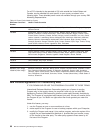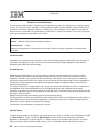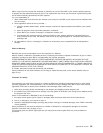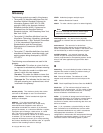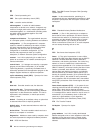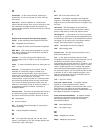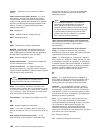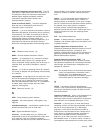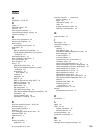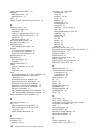
Glossary
The following symbols are used in this glossary:
v The symbol (A) identifies definitions from the
American National Standard Dictionary for
Information Systems, ANSI X3.172-1990,
copyright 1990 by the American National
Standards Institute (ANSI). Copies can be
purchased from the American National
Standards Institute, 1430 Broadway, New York,
New York 10018.
v The symbol (I) identifies definitions from the
Information Technology Vocabulary, developed
by Subcommittee 1, Joint Technical Committee
1, of the International Organization for
Standardization and the International
Electrotechnical Commission (ISO/IEC
JTC1/SC1).
v The symbol (T) identifies definitions from draft
international standards, committee drafts, and
working papers being developed by ISO/IEC
JTC1/SC1.
The following cross-references are used in this
glossary:
Contrast with. This refers to a term that has
an opposed or substantively different meaning.
See. This refers the reader to multiple-word
terms in which this term appears.
See also. This refers the reader to terms that
have a related, but not synonymous, meaning.
Synonym for. This indicates that the term has
the same meaning as a preferred term, which
is defined in the glossary.
A
access priority. The maximum priority that a token
can have for the adapter to use it for transmission.
adapter address. Twelve hexadecimal digits that
identify a LAN adapter.
address. (1) In data communication, the
IEEE-assigned unique code or the unique locally
administered code assigned to each device or
workstation connected to a network. (2) A character,
group of characters, or a value that identifies a register,
a particular part of storage, a data source, or a data
sink. The value is represented by one or more
characters. (3) To refer to a device or an item of data by
its address. (4) The location in the storage of a
computer where data is stored. (5) In word processing,
the location, identified by the address code, of a specific
section of the recording medium or storage.
APAR. Authorized program analysis report.
ARP. Address Resolution Protocol.
attach. To make a device a part of a network logically.
Note:
Not to be confused with connect, which implies
physically connecting a device to a network.
attaching device. Any device that is physically
connected to a network and can communicate over the
network.
auto-removal. The removal of a device from
data-passing activity without human intervention. This
action is accomplished by the adapter in the device, and
can be initiated by a network management program.
available memory. In a personal computer, the
number of bytes of memory that can be used after
memory requirements for the operating system, device
drivers, and other application programs have been
satisfied.
B
beaconing. An error-indicating function of token-ring
adapters that assists in locating a problem causing a
hard error on a token-ring network.
BIA. Burned-In Address. The address of a LAN
adapter card, burned into the card and unique to the
card.
BIOS. Basic Input/Output Services. See also NetBIOS.
block size. (1) The minimum size that frames are
grouped into for retransmission. (2) The number of data
elements (such as bits, bytes, characters, or records)
that are recorded or transmitted as a unit.
buffer. (1) A portion of storage used to hold input or
output data temporarily. (2) A routine or storage used to
compensate for a difference in data rate or time of
occurrence of events, when transferring data from one
device to another.
bus. (1) In a processor, a physical facility on which
data is transferred to all destinations, but from which
only addressed destinations may read in accordance
with appropriate conventions. (2) A network
configuration in which nodes are interconnected through
a bidirectional transmission medium. (3) One or more
conductors used for transmitting signals or power.
© Copyright IBM Corp. 2000 97




